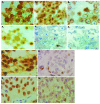Effects of glucocorticoids on the growth and chemosensitivity of carcinoma cells are heterogeneous and require high concentration of functional glucocorticoid receptors
- PMID: 16419168
- PMCID: PMC4320343
- DOI: 10.3748/wjg.v11.i40.6373
Effects of glucocorticoids on the growth and chemosensitivity of carcinoma cells are heterogeneous and require high concentration of functional glucocorticoid receptors
Abstract
Aim: To determine how glucocorticoids (GCs) may affect the growth and chemosensitivity of common carcinoma cells.
Methods: The effect of dexamethasone (DEX) on growth and chemosensitivity was assessed in 14 carcinoma cell lines. The function of GC receptors (GR) was assessed by MMTV reporter assay. Overexpression of GR was done by in vitro transfection and expression of a GR-expressing vector. Immunohistochemical stain of tissues and cells were done by PA1-511A, an anti-GR monoclonal antibody.
Results: DEX inhibited cell growth of four (MCF-7, MCF-7/MXR1, MCF-7/TPT300, and HeLa), increased cisplatin cytotoxicity of one (SiHa), and decreased cisplatin cytotoxicity of two (H460 and Hep3B) cell lines. The GR content of the seven cell lines affected by DEX was significantly higher than those of the seven cell lines unaffected by DEX (5.2+/-2.5 x 10(4) sites/cell vs 1.3+/-1.4 x 10(4) sites/cell, P = 0.005). Only two DEX-unresponsive cell lines (NPC-TW01 and NPC-TW04) contained high GR amounts in the range (1.9-8.1 x 10(4) sites/cell) of the seven DEX-responsive cell lines. The GR function of NPC-TW01 and NPC-TW04, however, was found to be impaired. The importance of high cellular amount of GR in mediating DEX susceptibility of the cells was further exemplified by GR dose-dependent drug resistance to cisplatin of AGS, a cell line with low GR content and was unaffected by DEX before transfection of GR-expressing vector. Immunohistochemical studies of human cancer tissues showed that 5 of the 45 (11.1%) breast cancer and 43 of the 85 (50.6%) non-small cell lung cancer had high GR contents at the ranges of the GC-responsive carcinoma cell lines.
Conclusion: The growth and chemosensitivity of human carcinomas with high GR contents may be affected by GC. However, in light of the heterogeneous and even contradictive effects of GC on these cells, routine examination of GR contents of human carcinoma tissues may not be clinically useful until other markers that help predict the ultimate effect of GC on individual patients are identified.
Figures




References
-
- Frankfurt O, Rosen ST. Mechanisms of glucocorticoid-induced apoptosis in hematologic malignancies: updates. Curr Opin Oncol. 2004;16:553–563. - PubMed
-
- Wright AP, Zilliacus J, McEwan IJ, Dahlman-Wright K, Almlöf T, Carlstedt-Duke J, Gustafsson JA. Structure and function of the glucocorticoid receptor. J Steroid Biochem Mol Biol. 1993;47:11–19. - PubMed
-
- Schwartzman RA, Cidlowski JA. Glucocorticoid-induced apoptosis of lymphoid cells. Int Arch Allergy Immunol. 1994;105:347–354. - PubMed
-
- McEwan IJ, Wright AP, Gustafsson JA. Mechanism of gene expression by the glucocorticoid receptor: role of protein-protein interactions. Bioessays. 1997;19:153–160. - PubMed
Publication types
MeSH terms
Substances
LinkOut - more resources
Full Text Sources
Medical
Miscellaneous

